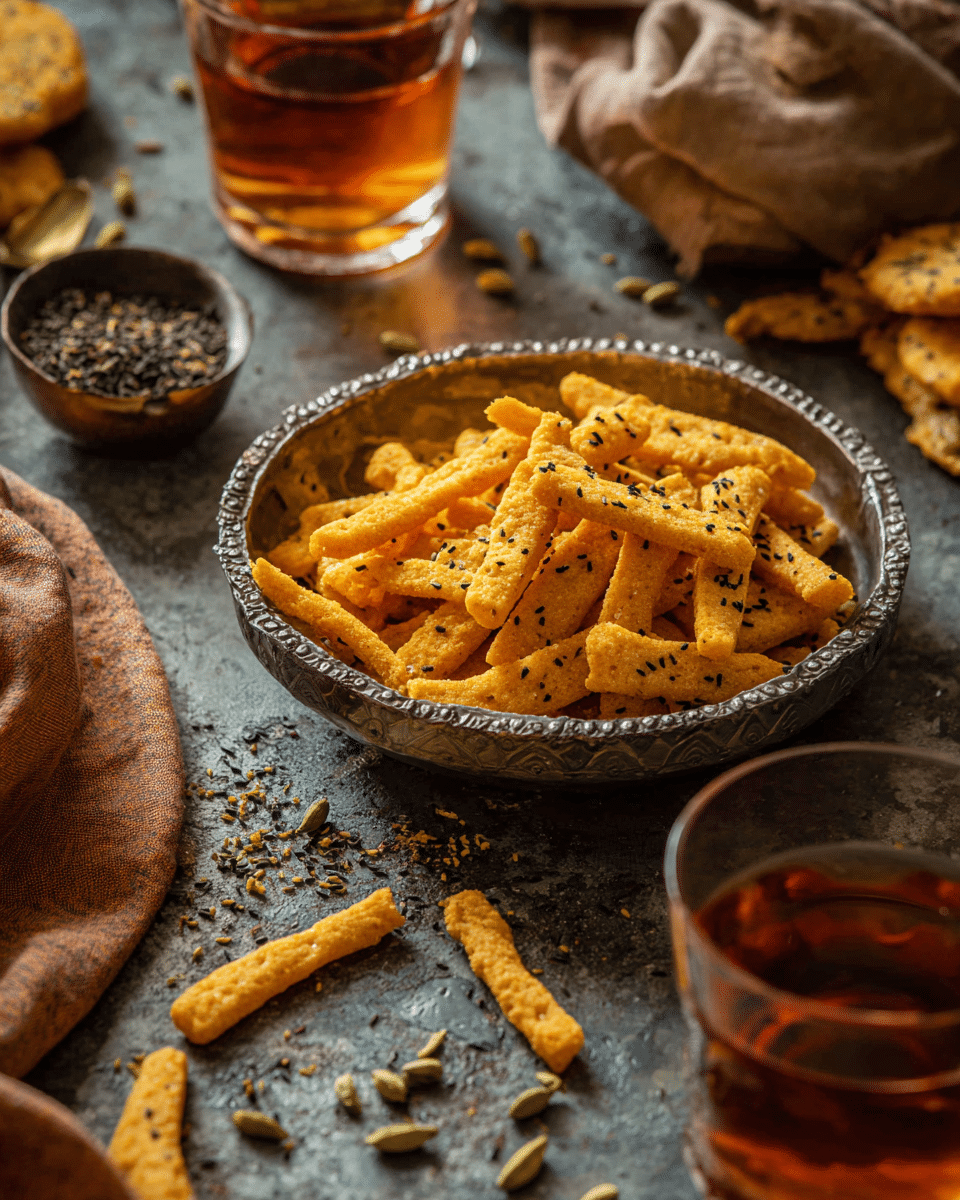Crispy Namak Para is a classic Indian savory snack made from simple pantry ingredients, popular during festive occasions like Raksha Bandhan. These crunchy, deep-fried strips of spiced dough are lightly salted and seasoned, making them a perfect tea-time treat or festive nibble for family gatherings.
FULL RECIPE
Ingredients
- 1 ½ cups all-purpose flour (maida)
- 2 tablespoons semolina (sooji/rava)
- 2 tablespoons oil or ghee
- ½ teaspoon carom seeds (ajwain)
- ½ teaspoon cumin seeds (jeera)
- ½ teaspoon salt (adjust to taste)
- Water, as needed to knead the dough
Oil, for deep frying
Directions
- In a large mixing bowl, combine all-purpose flour, semolina, carom seeds, cumin seeds, and salt. Mix well.
- Add oil or ghee into the flour mixture and rub with fingers until it resembles breadcrumbs.
- Gradually add water, a little at a time, and knead into a firm but pliable dough. Cover and let it rest for 15–20 minutes.
- Divide the dough into two equal portions. Roll each portion into a thick disc, about ¼ inch thick.
- Using a sharp knife or a pizza cutter, cut the rolled dough into diamond or rectangular shapes.
- Heat oil in a deep pan over medium heat. Once hot, add a few pieces at a time, ensuring not to overcrowd the pan.
- Fry the Namak Para on medium-low heat, turning occasionally, until they are golden brown and crisp.
- Remove them with a slotted spoon and place on paper towels to drain excess oil.
- Let them cool completely before storing in an airtight container.
Nutrition Facts
- Calories: 210
- Total Fat: 11g
- Saturated Fat: 1.5g
- Trans Fat: 0g
- Cholesterol: 0mg
- Sodium: 200mg
- Total Carbohydrates: 25g
- Dietary Fiber: 1g
- Sugars: 0g
- Protein: 3g
Cultural Significance of Namak Para
Namak Para holds a beloved place in Indian culinary traditions, especially during festivals like Raksha Bandhan and Diwali. It is a quintessential snack often made in large batches at home, symbolizing familial love, warmth, and celebration. In many households, mothers and grandmothers prepare Namak Para days ahead of the festivities, filling kitchen jars with these crispy bites to be shared with guests and loved ones. The process of making Namak Para together also becomes a cherished family activity, passing down both recipes and stories through generations.
Texture and Flavor Profile
One of the key attractions of Namak Para is its irresistible texture—crunchy on the outside with a slightly tender bite inside. The addition of semolina gives it an extra crispness, while the carom and cumin seeds add subtle yet aromatic earthy notes. Salt is the predominant seasoning, but its balance with the toasted spices creates a deep, savory flavor that makes it hard to stop at just one. It’s not overwhelmingly spicy or salty, making it a snack that appeals to all ages.
Health Considerations
While traditionally deep-fried, Namak Para can be modified to suit health-conscious eaters. Using whole wheat flour instead of refined flour increases its fiber content, supporting better digestion and reducing blood sugar spikes. Baking instead of frying can significantly reduce the fat content while still maintaining a good crunch. Additionally, using heart-healthy oils like olive or avocado oil for frying, or even air-frying, can make this treat a lighter indulgence suitable for modern dietary preferences.
Recipe Variations
There are numerous regional and modern variations of Namak Para. In some North Indian versions, the dough includes crushed black pepper for a spicier bite. Others might substitute herbs like dried fenugreek leaves (kasuri methi) or even add a pinch of turmeric for a golden hue and added health benefits. South Indian adaptations may incorporate curry leaves for a distinctive aroma. For those who prefer a sweeter counterpart, Shakkar Para is a close cousin, made with sugar instead of salt and flavored with cardamom.
Serving Suggestions
Namak Para is incredibly versatile when it comes to serving. It is commonly enjoyed with a cup of masala chai, where its savory crunch perfectly complements the spiced warmth of the tea. It also pairs well with a cooling glass of lassi or buttermilk during summer months. For festive presentations, it can be served alongside other traditional snacks like mathri, chakli, or sev on a decorative platter. It also works well as a party snack, easily stored and served in bowls during casual get-togethers.
Perfect Pairings
While tea is the go-to partner for Namak Para, it also pairs beautifully with yogurt-based dips or spicy chutneys for a flavor upgrade. A mint-coriander chutney or garlic tomato chutney can elevate its flavor and offer contrast. In festive thalis or snack boxes, pairing Namak Para with sweets like besan ladoo or kaju katli creates a satisfying sweet-and-savory balance. You can also use it as a base in Indian-style snack mixes, combined with roasted nuts and sev to create your own trail mix.
Storage and Shelf Life
One of the most convenient aspects of Namak Para is its long shelf life. When stored in an airtight container, it can last up to three to four weeks without losing its crunch. It is important to let the fried pieces cool completely before storing them to prevent any residual steam from softening them. For extended freshness, consider lining the container with a paper towel to absorb any remaining oil. This makes it an ideal snack to prepare in advance for holidays, travel, or gifting.
Tips for Best Results
To achieve the best texture and taste, the dough for Namak Para should be firm and not too soft. Overly soft dough can absorb more oil and result in greasy snacks. Frying on medium heat is crucial—if the oil is too hot, the Namak Para will brown quickly on the outside while remaining undercooked inside; too cold, and they will become soggy. Rolling the dough evenly ensures uniform cooking, and cutting the pieces consistently prevents over- or under-frying. Always test one piece before frying the full batch.
Kid-Friendly Snack Option
Namak Para is a great addition to children’s snack boxes, especially when prepared in fun shapes like stars or animals. Because it’s not spicy, it’s ideal for younger palates. Parents can sneak in nutrition by using multigrain or millet flours and adding grated veggies like spinach or carrot to the dough. It’s mess-free, non-perishable, and easy to eat with little hands, making it a lunchbox favorite. For added fun, you can even involve kids in cutting out the shapes before frying or baking.
Make-Ahead and Gifting Ideas
Namak Para is perfect for make-ahead snack planning. You can prepare large batches and store them for unexpected guests or busy weekdays. During festive seasons, it becomes a thoughtful edible gift when packed in decorative jars or gift boxes. Layering it with sweet treats in clear containers creates a visually appealing and delicious festive hamper. Homemade snacks like this not only offer a personal touch but also avoid preservatives and artificial flavorings, making them healthier and more heartfelt gifts.
Conclusion
Crispy Namak Para is more than just a snack—it’s a delicious symbol of tradition, sharing, and celebration. Its simple ingredients and customizable nature make it a favorite across generations and occasions. Whether served during festive gatherings, enjoyed with evening tea, or given as a homemade gift, Namak Para brings a satisfying crunch and savory charm to every bite. With room for innovation and adaptation, this timeless snack continues to hold its place in modern Indian kitchens, uniting flavors of the past with the possibilities of today.






